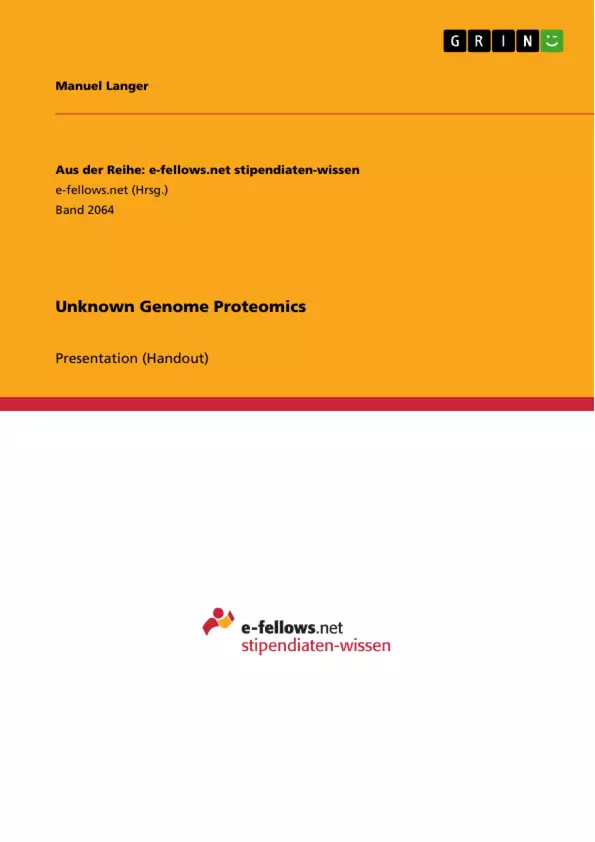The presentation deals with the problem of traditional proteomics like strong sequence polymorphism or poorly conserved protein families.
The worklow of this technique is displayed in detail and involves MS/MS analysis as well as data base research.
Inhaltsverzeichnis (Table of Contents)
- Problems of,traditional' proteomics
- Solution
- Workflow similarity-driven proteomics
- Evaluate borderline hits
- Filtering against background library
- Protein Identification of D. Salina
- Proteomics-genomics approach: workflow
- 2D-Gel electrophoresis of soluble fraction
- Edman degradation and IPCR
- IPCR
- Identification of ORF
Zielsetzung und Themenschwerpunkte (Objectives and Key Themes)
This presentation explores the challenges of 'traditional' proteomics when dealing with species that are phylogenetically distant and have poorly conserved protein families. It proposes a solution involving a combination of MASCOT search and sequence similarity-driven proteomics, integrating genomics and proteomics. The presentation then delves into the workflow of similarity-driven proteomics, highlighting the importance of filtering against background libraries and evaluating borderline hits.
- Challenges of traditional proteomics in phylogenetically distant species
- Integration of genomics and proteomics for protein identification
- Workflow of similarity-driven proteomics
- Importance of background library filtering
- Validation of borderline hits
Zusammenfassung der Kapitel (Chapter Summaries)
- Problems of,traditional' proteomics: This section outlines the challenges of traditional proteomics methods when applied to species with poorly conserved protein families and undefined genetic backgrounds. It emphasizes the limitations of relying solely on MASCOT search, particularly in the context of strong sequence polymorphism.
- Solution: This section proposes a solution that combines MASCOT search with sequence similarity-driven proteomics. It highlights the benefits of integrating genomics and proteomics data for a more comprehensive protein identification approach.
- Workflow similarity-driven proteomics: This section details the workflow of similarity-driven proteomics, starting with database search (MASCOT) and progressing through steps like spectra assignment, filtering against background libraries, and de novo sequencing. It emphasizes the role of MS BLAST and borderline hit validation.
- Evaluate borderline hits: This section focuses on the evaluation of borderline hits, those with only a few matching peptides in the MASCOT search. It describes the use of de novo interpretation of borderline peptides and MS BLAST searches to identify related database entries.
- Filtering against background library: This section highlights the importance of filtering against background libraries to reduce false positives. It illustrates the concept through a case study of D. salina, demonstrating how background filtering can improve protein identification accuracy.
- Protein Identification of D. Salina: This section presents a specific example of protein identification in D. salina, using both MASCOT and MS BLAST searches. It showcases the effectiveness of the combined approach in identifying both known and novel proteins.
- Proteomics-genomics approach: workflow: This section outlines the workflow of a proteomics-genomics approach, combining proteomics data with genomic information to identify proteins. It details the steps involved, from N-terminal sequencing to IPCR and protein identification through FTICR-MS. This approach is particularly useful for organisms with unknown genomes.
- 2D-Gel electrophoresis of soluble fraction: This section illustrates the application of 2D-gel electrophoresis in separating soluble proteins. It provides visual representations of protein patterns under different conditions, highlighting the potential for identifying differentially expressed proteins.
- Edman degradation and IPCR: This section focuses on Edman degradation and IPCR as techniques for protein sequence determination. It demonstrates how these methods can be used to identify phosphite-induced proteins in D. phosphitoxidans, a sulfate-reducing bacterium.
- IPCR: This section elaborates on the IPCR technique, specifically its use in amplifying DNA fragments containing the coding sequence of a protein. It describes how IPCR can be combined with Edman sequencing to identify ORFs (open reading frames) within a genome.
- Identification of ORF: This section presents a case study of ORF identification using a combination of Edman sequencing, IPCR, and MALDI-FTICR-MS. It highlights the successful identification of a putative epimerase/dehydratase in D. phosphitoxidans, demonstrating the power of integrating different proteomics and genomics techniques.
Schlüsselwörter (Keywords)
The core focus of this presentation lies in the realm of proteomics, particularly addressing the challenges of identifying proteins in species with poorly conserved protein families and unknown genomes. Key themes include the integration of genomics and proteomics data, the development of similarity-driven proteomics workflows, and the importance of background library filtering and borderline hit validation. This presentation also explores specific examples of protein identification in D. salina and D. phosphitoxidans, employing techniques like MASCOT search, MS BLAST, Edman degradation, IPCR, and MALDI-FTICR-MS.
- Arbeit zitieren
- Manuel Langer (Autor:in), 2015, Unknown Genome Proteomics, München, GRIN Verlag, https://www.grin.com/document/337836



